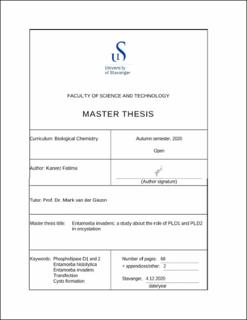| dc.contributor.advisor | van der Giezen, Mark | |
| dc.contributor.author | Kaneez, Fatima | |
| dc.date.accessioned | 2021-06-24T10:28:35Z | |
| dc.date.available | 2021-06-24T10:28:35Z | |
| dc.date.issued | 2020-12 | |
| dc.identifier.uri | https://hdl.handle.net/11250/2761088 | |
| dc.description | Master's thesis in Biological chemistry | en_US |
| dc.description.abstract | One of the most common problem in the developing world is infectious diseases caused by poor living conditions and one such condition is called amoebiasis. The causative agent of which is Entamoeba histolytica; a microaerophilic, parasitic amoebozoan species, which causes intestinal and extraintestinal amoebiasis in humans. Although there are certain drugs available for treating this disease, more research is needed to come up with novel drugs. Furthermore, basic research is needed to understand the different stages of its life cycle and possible therapies during its dormant stages. One such stage is the encystation of its cell, a crucial stage which basically involves the transformation of motile trophozoite into resistant cyst. It is extremely difficult to treat cysts, and a growing body of research has shown that phospholipase D (PLD) activity is significantly increased in Entamoeba histolytica during encystation, indicating that it plays a critical role in cyst formation. PLD is a widely distributed enzyme in all branches of life that hydrolyzes phosphatidylcholine. It is believed to play an important role in the regulation of cell physiology by extracellular signals such as hormones, neurotransmitters, growth factors, and cytokines. Due to our inability to effectively induce encystation in vitro in Entamoeba histolytica, our knowledge about the cyst form remains limited. This also hampers our ability to develop cyst-specific diagnostic tools. This thesis is about role of PLD during cyst formation in Entamoeba. In this study we attempted to investigate a potential role of PLD during encystation in the laboratory model organism Entamoeba invadens as encystation is not experimentally achievable in human parasite Entamoeba histolytica. The research included amplification of PLD1 and PLD2 genes by extraction of genomic DNA and cloning of the genes into standard cloning vector pGEM-T-Easy and then in the Entamoeba-specific vector pEiNEO. Electroporation of the cloned Entamoeba specific vectors was performed by transfecting the Entamoeba invadens trophozoite cells. On other hand, encystation activity was also checked by introducing 0.6% n-butanol and t-butanol in 50% LYG media (encystation medium) but it did not show any significant inhibition. Fluorescent microscopy results showed no effect of n-butanol on cysts formation. Bioinformatics investigation showed that the HKD active site motif of PLD was found conserved throughout Entamoeba species as in animal, plants, and fungi. | en_US |
| dc.language.iso | eng | en_US |
| dc.publisher | University of Stavanger, Norway | en_US |
| dc.relation.ispartofseries | Masteroppgave/UIS-TN-IKBM/2020; | |
| dc.rights | Navngivelse 4.0 Internasjonal | * |
| dc.rights.uri | http://creativecommons.org/licenses/by/4.0/deed.no | * |
| dc.subject | Phospholipase D1 and 2 | en_US |
| dc.subject | Entamoeba histolytica | en_US |
| dc.subject | Entamoeba invadens | en_US |
| dc.subject | transfection | en_US |
| dc.subject | cyst formation | en_US |
| dc.subject | biokjemi | en_US |
| dc.subject | biologisk kjemi | en_US |
| dc.title | Entamoeba invadens; a study about the role of PLD1 and PLD2 in encystation | en_US |
| dc.type | Master thesis | en_US |
| dc.subject.nsi | VDP::Matematikk og Naturvitenskap: 400::Basale biofag: 470::Biokjemi: 476 | en_US |

